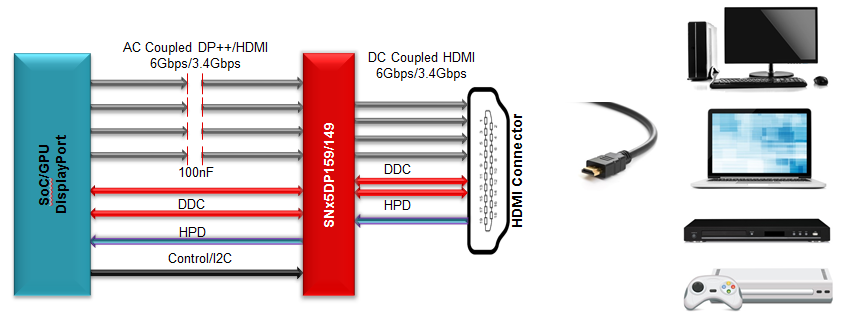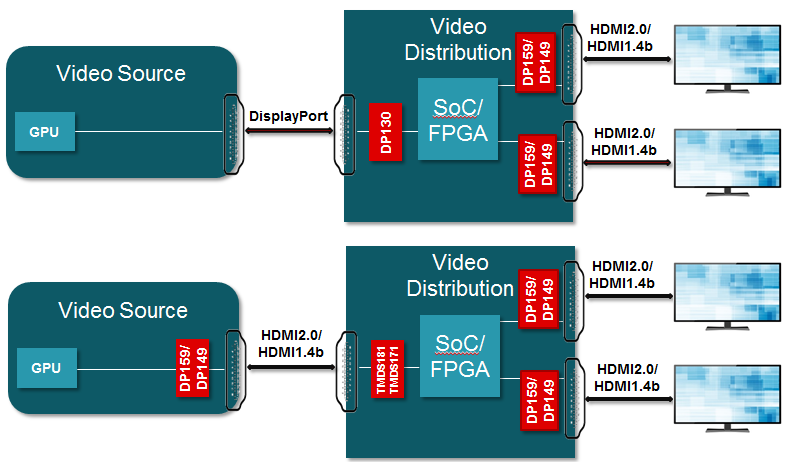SSZTB69 june 2016 SN65DP149 , SN65DP159 , SN75DP149 , SN75DP159 , TMDS171 , TMDS181
Signals that traverse through transmission media are subject to the effects of noise, distortion and signal loss. While you can typically preserve signal integrity and fidelity at low bit rates and enable longer distances, DisplayPort and high-definition multimedia interface (HDMI®) multi-gigabit signals usually experience significant signal-integrity degradation when signals traverse through long traces across connectors or over long cables. These long lengths could result in reduced signal strength, distorted or noisy signals at the receiving end, or the signal failing to comply with standards.
By using retimers and redrivers in DisplayPort or HDMI interfaces, video systems can maintain signal integrity over long traces or cables with improved signal quality. This facilitates design flexibility by extending the distance through which a signal can travel across cables or traces. Retimers and redrivers also enable a broad range of interoperability, improve system performance, and help systems comply with standards-driven requirements.
The most common usage for retimers and redrivers is on the video source side in notebooks, desktops, gaming systems and DVD players, where the devices sit between the video output from the system-on-chip (SoC) or graphics processing unit (GPU) and the HDMI connector, before the retimers or redrivers transmit the video signal through the HDMI cable to the monitor, HDTV, etc. Figure 1 shows the use of a retimer in a video source side system design.
 Figure 1 Retimer Used on the Video
Source Side
Figure 1 Retimer Used on the Video
Source SideAnother area where retimers and redrivers can benefit systems is in video distribution, where an SoC or field-programmable-gate-array (FPGA) may output different video channels. The designer can embed a retimer or redriver in each channel before they transmit the signal into the HDMI connector, as shown in Figure 2.
 Figure 2 Using Retimers in a Video
Distribution System
Figure 2 Using Retimers in a Video
Distribution SystemDevices like the SNx5DP159 and SNx5DP149 high-performance dual-mode DisplayPort or transition-minimized differential signaling (TMDS)-to-HDMI retimers provide a system’s signal-conditioning needs. Let me give you two specific examples of how retimers can help increase signal integrity in video display system designs.
Increasing Signal Integrity in Dongle System Designs
To enable DisplayPort signals to transmit over HDMI interface, dual-mode DisplayPort (DP++) allows DisplayPort interoperability with digital visual interface (DVI) and HDMI interfaces by using a simple adapter to output DVI and HDMI formats while also adding three capabilities to DisplayPort:
- Adding a DP_PWR DisplayPort receptacle power pin to provide power to a video adapter
- Adding CONFIG1 and CONFIG2 to provide a discovery mechanism for dual-mode video adapters
- Adding an I2C-over-AUX channel to be used for the HDMI display data channel (DDC) interface
There are two types of dual-mode DisplayPort adapters. Type 1 supports a maximum TMDS clock rate of 165 MHz for both DVI and HDMI, and DDC signaling through I2C. Type 2 supports a maximum TMDS clock rate of 165 MHz for DVI and 300 MHz for HDMI, and both DDC and I2C-over-AUX signaling.
In a dual-mode DisplayPort to HDMI dongle, DP159/DP149 retimers improve signal quality, as illustrated in Figure 3.
 Figure 3 The DP159/DP149 Retimers Used in a Video DisplayPort-to-HDMI Dongle
Figure 3 The DP159/DP149 Retimers Used in a Video DisplayPort-to-HDMI DongleSignal Conditioning in Docking Station Designs
Here’s the second example. A docking station usually serves as a video source to connect laptops, notebooks and mobile devices to a monitor. A docking station typically has a sink-loss profile because of how it connects to the video source. Serving as a signal conditioner, the DP159/DP149 retimers boost signal strength and deliver a cleaner signal to the monitor. Figure 4 shows the DP159/DP149 retimer in a docking station application.
 Figure 4 DP159/149 Retimer Used in a Docking Station Application
Figure 4 DP159/149 Retimer Used in a Docking Station ApplicationIn addition to the video system applications I’ve mentioned above, you can use the DP159 and DP149 devices in many other system designs, including desktop PC, laptop, gaming PC, DVD, and AVR applications. What considerations do you face when designing video distribution systems? Log in to post a comment below.
Additional Resources
- Download the data sheets for the SNx5DP159 and SNx5DP149 devices.
- Read the white paper, “Build a true fidelity system using video signal conditioners.”